Crete 6th century BC: a tool to to teach meditation in Europe for up to 1,800 years
Phaistos Disk
Was the Phaistos Disk a master key, designed as a tool to teach meditation in the 6th century BC by Pythagoras, Greek mathematician and first to call himself a philosopher?
Phaistos Crete: Neolithic palace or a Buddhist learning centre?
Were the ruins of Phaistos abandoned after an earthquake in the Neolithic c. 1300 BC or was the site used until at least the 5th century as a learning centre where Linear A and B clay tablets were used to teach students?
Phaistos find-spot in Crete: palace or learning centre?
Knossos Linear B clay tablet meditation illustrated: dissolution
Knossos Linear B clay tablet: working of the mind, 6th sense
Phaistos Disk timeline:
key to mysteries of Europe
Was the Phaistos Disk, discovered i in a plastered-over basement surrounded by an abundance of ashes, a prime object that was part of a valued collection that included texts in a library when the site was destroyed?
Is the Phaistos Disk a Master Key that can be used to unlock the lost links of history in Europe, as illustrated on the timeline?
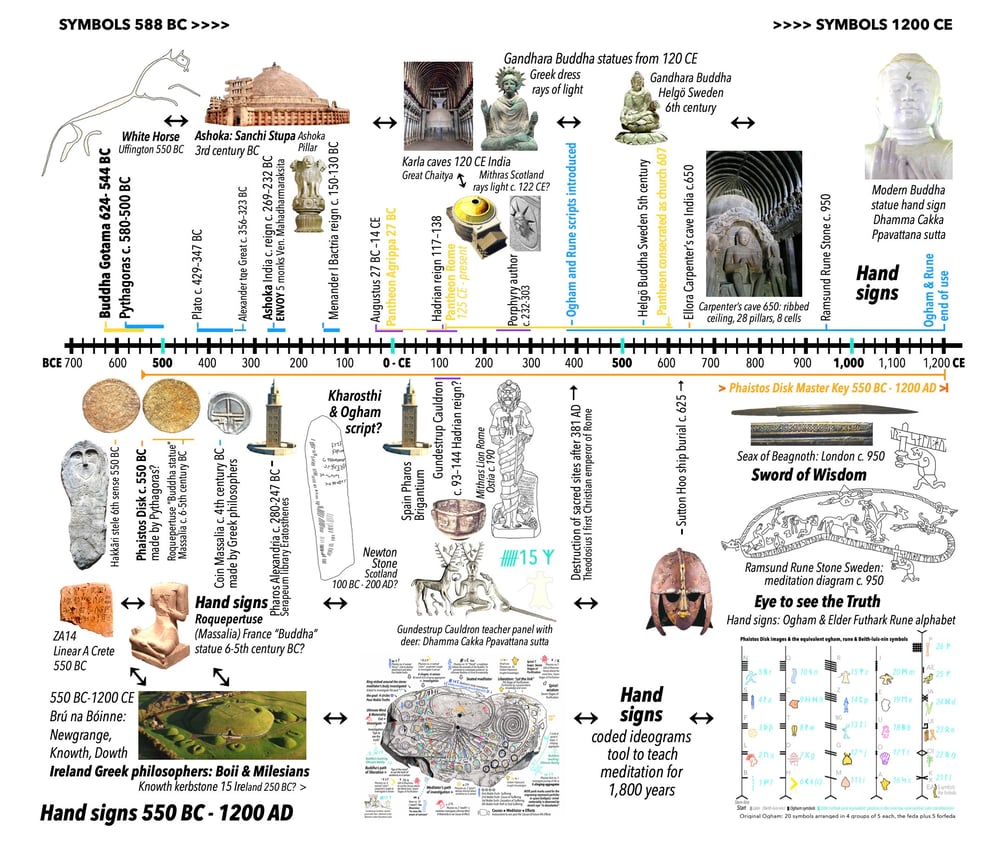
Phaistos Disk made by Pythagoras?
Animated text clip, no sound.
Was the Phaistos Disk of Crete made by Pythagoras in the 6th century BC? Pythagoras (c. 580–500 BC) was a contemporary of the Buddha Gotama (c. 624 – 544 BC) in India, he was about 36 years old when the Buddha entered Parinibbāna.
If his teachings of “metempsychosis” (knowledge of past lives), was based on Dependent Origination as taught by the Buddha, the symbols on the Phaistos disk and the Linear A and Linear B scripts were “ideograms” to teach meditation step by step, and not the lost phonetic alphabets of ancient Greek dialects as thought.
Phaistos Disk 47 symbols: a fixed linear ordrer
The 47 individual symbols of the Phaistos Disk appeared in a linear order with a special meaning: a system of numbers to represent ideograms to explain the meditation system, originally taught by the Buddha Gotama in India in the 6th century BC.
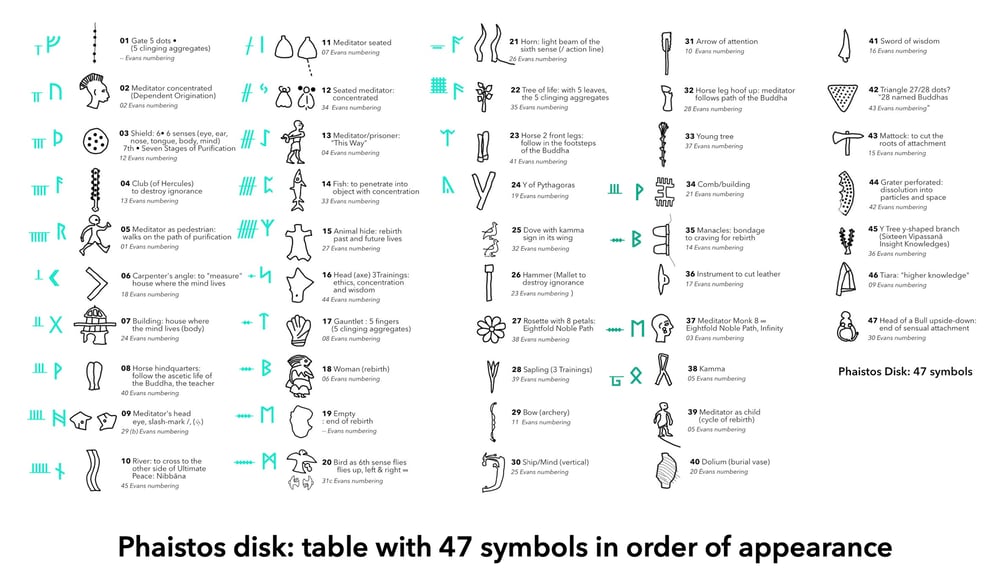
Phaistos Disk Master Key:
a tool to teach meditation
Animated text clip, no sound.
47 symbols were imprinted repeatedly on a 15 cm oval clay disk in a seemingly chaotic mix, but with careful observation intricate patterns with multiple layers of knowledge appe.
When following lines in the clay that link clusters of symbols, threads of information reveal a network of knowledge that was well known and practiced in Europe for at least 1,800 years. Not limited by language barriers images were used to create “mathematical formulas” compatible with the meditation system taught by the Buddha Gotama in India in the 6th century BC and introduced into Greece by Pythagoras, mathematician and the first to call himself a philosopher: “one who loves wisdom”.
Comparison of “secret scripts” in Europe
Still famous as a mathematician, Pythagoras was skilled in various forms of writing learnt in Mesopotamia and from the Pharaoh Amasis II and priests in Egypt, Pythagoras was the first to call himself a philosopher – “one who loves wisdom”. Did Pythagoras design the Phaistos Disk images, similar to Egyptian hieroglyphs, as a system to teach meditation to his students?
Was Pythagoras a follower of the Buddha?
PYTHAGORAS DESIGNER OF “IDEOGRAMS”
The Greek equivalent of Dependent Origination – “metempsychosis” – was taught by Pythagoras, the “first to introduce the teachings into Greece” (Porphyry c. 232–303, “Life of Pythagoras”).
Was Pythagoras (c.580-500 BCE) a follower of the Buddha in India (624-544 BCE)?
The Buddha taught that actions are the Causes that will inevitably result in Effects. Personal kamma will have its effect as rebirth in future lives, but when investigating past lives the natural law of Dependent Origination will be seen . The root – craving – can be cut through concentration.

Phaistos Disk original source: Ogham & Runes
SECRET SCIPTS AND POEMS WITH RIDDLES
After the 5th century new scripts appeared in northern Europe, thought to be secret, but the abstract codes strictly followed the numbers of the Phaistos Disk. With the help of these scripts, each symbol described as a riddle in Rune Poems, the Phaistos Disk of Crete can still be deciphered.
A selection was made of the first 25 symbols that appeared on the Phaistos Disk to create a kind of “shorthand” used to write votive messages: 25 for the Ogham of Ireland, 24 symbols for the Elder Futhark and 28 symbols or the Anglo-Saxon Futhork. The Younger Futhork with only 16 symbols was introduced as a shortened version, used until at least the 12th century in Sweden to make votive inscriptions on standing stones.
Reading the Phaistos Disk:
linear and circular (in four dimensions)
TWO SIDES: CAUSES & EFFECTS
The Phaistos Disk can be interpreted at various levels to reveal an ever more complex explanation of the meditation system originally taught by the Buddha in the 6th century BC.
The first level of meaning is having 2 sides on one disk: to investigate Causes that result in Effect as future rebirth.
Linear order:
follow the 47 symbols as imprinted
LINEAR ORDER
Starting with symbol 1, the gates of concentration with 5● – the 5 clinging aggregates, investigation of existence as Ultimate Reality of Mind (nāma) and Materiality (rūpa) – the meditator is a warrior (symbol 2). The warrior uses a shield (symbol 3), the Three Trainings (sīla ethics, samādhi concentration and paññā wisdom) to investigate the six senses. Through attainment of Four Noble Truths (symbol 4) he will be able to destroy ignorance with the Club of Hercules to be able to end the journey of life in samsara: the pedestrian (symbol 5). The method is to “analyse the 6 senses with attention”, carpenter’s angle. The goal is to “break down the house where the mind lives ” (symbol no. 7) built with the building blocks of kamma, life after life.
In the same way every one of the 47 symbols can be interpreted.
Repetitions of each symbol:
codesto illustrate ideograms
REPETITIONS OF CODES WITH A MEANING: TOTAL – SIDE A – SIDE B
47 symbols were used, the total number of times they were repeated tells what the definition of the symbol is, the number of times repeated on either side A or side B represent actions to be taken: meditation instructions.
A complete analysis with a detailed list is available in text about Ogham.
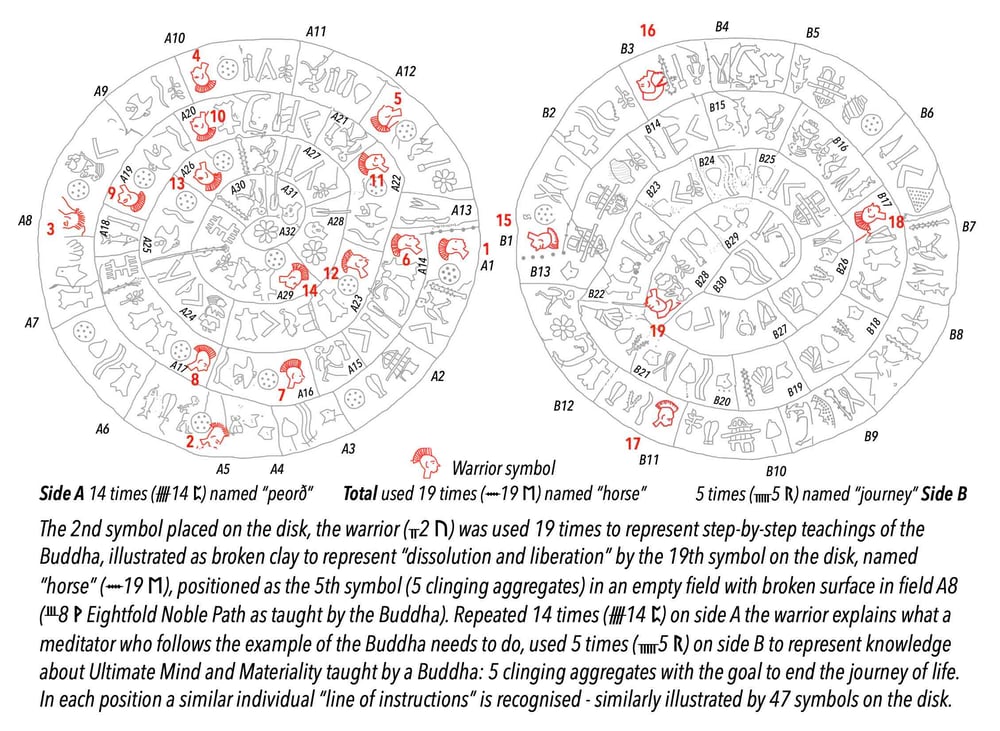
Phaistos Disk Fields: side A 32 & side B 30
SPIRALS DIVIDED INTO FIELDS
The linear spirals were broken into fields by adding lines as boundaries.
32 fields on side A indicate ’32 Marks of a Great Man” of the teacher: the qualities of the Buddha as described in a Pali text.
30 fields on side B are details of the Path of Purification followed by a meditator with the goal to “cross the ocean of samsara”.
The Buddha (side A 32 Marks of a Great Man) was described in texts as the “Captain of the ship” who will show the way to safely cross to the other shore of ultimate peace, Nibbāna (30 side B).
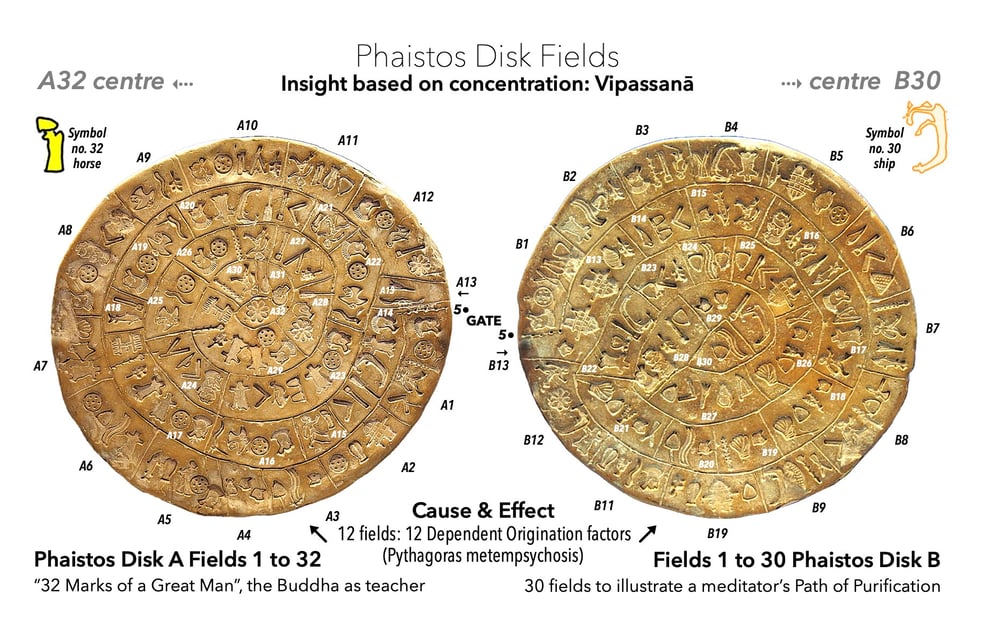
Phaistos Disk Fields: Four Noble Truths
as taught by the Buddha
Side A fields 12 + 20 = 32 & side B 12 + 18 = 30
FIELDS AND FOUR NOBLE TRUTHS
The Phaistos Disk was the prototype, designed to illustrate how to attain Four Noble Truths as taught by the Buddha in the 6th century BC.
Two outer rings with 12 fields each represent Dependent Origination, metempsychosis in Greek. The two rings represent the First Noble Truth, Suffering and the Second Noble Truth, Causes of Suffering: rebirth.
The inner spiral on side B with 18 fields represent the end of the cycle of rebirth, illustrated by a ‘mother image’ on the Phaistos Disk to illustrate rebirth, the “ᛒ” rune resemble manacles, to be tied to the rebirth cycle through craving for new existences.
The inner spiral on side A with 20 fields is likely to be the main source for the “holy number 20 of Pythagoras”, illustrated by the bird with a sign in its talons, either an 8 (Noble Eightfold Path) or the final goal, infinity ∞ Nibbāna. The 20th symbols was later illustrated with a rune of two facing axes that clash “ᛗ” named “mannaz”, which may be the original source for the name of the Isle of Man after “Mannanaz Mac Leir”.
Side A is an illustration of the Fourth Noble Truth, the Path that leads to the End of Suffering as taught by the Buddha.

Diagram of Four Noble Truths used until the 12th century
SIMPLIFIED DIAGRAM OF FOUR NOBLE TRUTHS ⊕
The original diagram of the Phaistos Disk was used in a simplified form as a cross in a circle ⊕ – that can be compared to a modern logo – illustrated on many Celtic coins and other objects until the 12th century. The shaven headed man with tattoo, -infinity & Eightfold Noble Path – may be a monk: liberation.
Phaistos Disk symbol no. 37: infinity tattoo on a shaven headed man (monk?): liberation
Celt coin Massalia 5th century BC, Roquepertuse “Buddha statue”: Four Noble Truths
Celt coin Volcae 50 BC: 2 “seeds of kamma”, eye to see the truth, axe – 4 Noble Truths
“5 clinging aggregates”: gateway of concentration
TO SEE ULTIMATE TRUTH OF MIND AND MATERIALITY (NĀMA & RŪPA)
Essential details of the Phaistos Disk were adapted by designers in different regions. The 5 clinging aggregates – “to observe Ultimate Reality” – was illustrated on many objects using abstract symbols.
550 BC (?): Phastos Disk gate of concentration: 5 clinging aggregates
250 BC (?): Newgrange kerbstone 1 with 5 spirals: 5 clinging aggregates
50 BC Celt coin Elusates: 5 dots & horn form an “eye to see the truth”, also on the Plougastel Daoulas stone in France
Phaistos Disk Master Key to illustrate the mind:
6th sense (hadaya vatthu)
SERIES OF NUMBERS APPLIED IN EUROPE FOR 1,800 YEARS
Different combinations of numbers as illustrated on the Phaistos Disk, the Master Key, were repeatedly used on objects from the 6th century BCE until at least 1200 CE. Maps exist with the link to India – Romans maintained a roads network from Scotland to the East Coast of India, mouth of the Ganges.
The knowledge in Europe of Buddhist meditation as illustrated on objects was never lost and is still taught in Asia as theory at university level and as meditation techniques, unchanged after 2,500 years.
550 BC (?): Phastos Disk combinations of numbers used until the 12th century
Distribution map with meditation objects in Europe: 6th century BCE until 1200 CE
27 BC Agrippa’s map engraved in marble: maintained Roman roads network, Scotland to India
Brú na Bóinne, Ireland : Place of the Boii tribe from Delphi?
6TH CENTURY BC PHILOSOPHER’S COLONY IN IRELAND?
Did philosophers from Delphi, the Boii, and the city Miletus, the Milesians, start a philosophers colony in Ireland after they fled from the Persian invasion of Greek Ionia in the 6th century BC?
Was the site a famous learning centre used until the 12th century, when people stopped meditating?
C. 550 BC “Place of the Boii”, Newgrange in Ireland: an early Greek philosopher’s colony of Magna Graecia after the Persian invasion ?
C. 250 BC Knowth kerbstone 15: engraving with an overview of the meditation system comparable to the Phaistos Disk
12-14th century Book of Leinster & Ballymote Ireland: corrupted Ogham tract, an illustrated guide that can be used to decipher engravings
Golden collars: to illustrate the function of the 6th sense
located in the heart?
THEME OF GOLDEN COLLARS IN EUROPE: FROM ITALY TO SWEDEN
In a world before texts was used, did they illustrate complex ideas using golden collars to illustrate how the 6th sense in the heart (hadaya vatthu in Pali) functions – seen as light during concentration?
C. 550 BC Eye of the mind: golden fibula & pectoral from the Lion Tomb in Etruscan Caere near Rome (Regolini-Galassi)
C. 550 BC Eye of the mind: golden fibula & pectoral from the Lion Tomb in Etruscan Caere near Rome (Regolini-Galassi)
C. 550 BC: Were golden collars in Ireland imitations of the elaborate fibula and collar in the Etruscan tomb of Caere (Rome)
C. 250 BC Knowth kerbstone 15: imitation of golden collars designed to give an overview comparable to Phaistos Disk?
5th century coded Massive Silver Chains Scotland: a meditator’s escape from imprisonment to the rebirth cycle
5th century complex design of Golden Collars of Sweden with multiple layers of knowledge: Âlleberg, Möne, Färjestaden
Follow in the footsteps of the horse: life as an ascetic
ASCETIC LIFE ILLUSTRATED BY HORSE IMAGES
Did Europeans choose a horse as an-iconic symbol to illustrate the ascetic life of the Bodhisatta who left the life as prince on his white horse Kanthaka to pursue liberation and to become the Buddha?
6th century BC Glauberg Prince: sprouting sapling & horse-man who will cut the roots of the tree of life: liberation
C. 2-1st century BC Parisii serpentine horse coin with coded symbols: a meditation diagram
Votive horse coins were minted in Europe before money was used especially to celebrate 500 years after the Buddha: 44 BC
A forgotten history: what did the Romans know?
ROMAN HORSE IMAGES TO ILLUSTRATE THE MIND
In Rome the floor pattern of the Pantheon built by Hadrian started with 20 blocks of marble, square with circles inside. Agrippa built the original Pantheon, they maintained a roads network from Scotland to the Ganges in India. Were history books corrupted, did at least some Romans rule from friendship rather than force? Did Romans support the sites of Maeshowe in Orkney and Newgrange in Ireland?
Roman parade helmets contained symbols of advanced meditation, they practiced the Mysteries of Mithras in manmade caves. Did Romans design the Hippika Gymnasia event where cavalry members wearing masks simulated celestial beings and knowledge of the 6th sense – the flight of a bird with feathers and ribbons to illustrate the concentrated mind – to simulate the bird illustrated on the Phaistos Disk, the “holy number 20 of Pythagoras”?
Did Romans design the Hippika Gymnasia event where cavalry dressed as birds to illustrate the concentrated mind – to copy the bird on the Phaistos Disk?
Boii horse coin and parade helmet with meditation codes from Scotland Trimontium c. 122 CE – Hadrian’s visit?
1st century Syria parade helmet with Bodhi tree leaves and rosette with 16 leaves: to see the Truth of Existence
125 CE Pantheon in Rome: designed mystic numbers of Pythagoras built by Hadrian
Did the Gundestrup Cauldron have the same function in the Pantheon, Rome as the massive stone cauldrons of Newgrange?
93-144 CE Gundestrup Cauldron teacher panel: designed by Hadrian to promote dialectics of philosophy?
Were Greek Linear A & B symbols used to design the Newgrange engravings, studied by the Romans?
Ptolemy Map of Ireland & Britain c. 140 CE & lighthouse, copy of Pharos of Alexandria built by Trajan/Hadrian in Spain
The Romans maintained a roads network from Scotland to the Ganges in India: did they practice Buddhist meditation?
Phaistos Disk Master Key used until the 12th century to illustrate knowledge of the 6th sense
PHAISTOS DISK MASTER KEY USED IN EUROPE
The series of images that represented numbers on the Phaistos Disk can be used as a master key to analyse and decipher complex objects, big and small, that were made from a variety of different materials during 1,800 years in Europe.
The knowledge found illustrated on the objects is still taught, both as theory at university level and as meditation techniques, unchanged after 2,500 years.
550 BC Tanumshede: Captain of the Ship, made during life of the Buddha and Pythagoras?
825 CE Viking coins Ribe: meditation diagram with deer & ship from the Phaistos Disk
c. 6th century Ireland Ballintaggart Ogham stone illustrated with equivalent Phaistos Disk images
32 runes on the rim: Golden Horns of Gallehus to illustrate the 6th sense Denmark
5th-9th century Norway: Eggja, Oseberg ship burial, Vang stone
10-11th century Sword of Wisdom Langeid Norway: with engravings of Newgrange?
10th century Manx old Irish High Cross: a meditation diagram combined with Ogham, not made by Christians
9-10th century Shandwick cross Scotland: illustrated meditation theory, silver chains with no. 20: Phaistos bird
10th century Ramsund rune stone Sweden: images from the Phaistos disk were copied to create a meditation diagram
Original meditation system
TAUGHT UNCHANGED AFTER 2,500 YEARS
Modern meditation chart comparable to the Phaistos Disk.
Theory is still taught at university level and meditation techniques practiced successfully under guidance of experienced teachers, also by westerners, taught unchanged after 2,500 years.
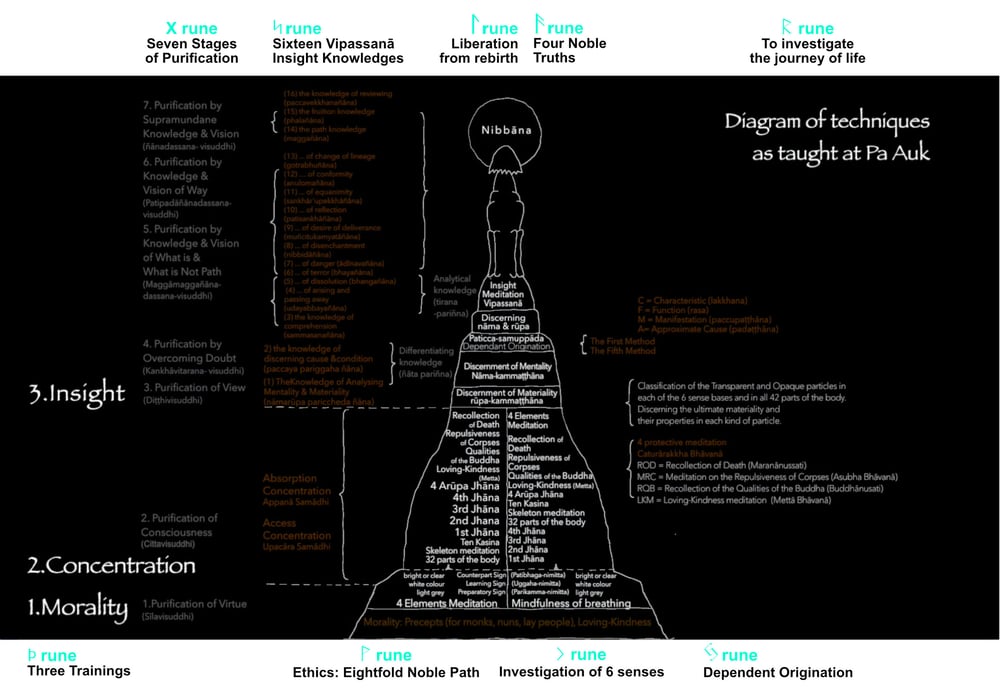
Sketch of an Excellent Man
In the Pa Auk Forest Monastery in Myanmar over a thousand people from all over the world are first taught 40 concentration techniques to be able to analyse the ultimate realities of Mind and Matter (Nāma and Rūpa) at subatomic particle level by “their own direct experience”.
They then proceed to practise Dependent Origination and Insight Meditation (Vipassanā) as described in the “Path of Purification” (Visuddhi Magga), a 1,500 year old summary of
the Pāli texts: the legacy of the profound practical knowledge as originally taught by Gotama the Buddha.
For people in search of the truth it can be a life changing experience to learn about “the wisdom light” produced by a concentrated mind found in the heart base – the sixth sense – described in detail.
Rare footage of the Most Venerable Pa Auk Tawya Sayadaw explaining Vipassanã and Dependent Origination in English, illustrated by an artist/architect (watercolour, animation) make this subtle and profound knowledge enjoyable to watch even by non practitioners.
Meditation: www.paaukforestmonastery.org
Translations available: English, Dutch, German, Lithuanian, Romanian, Russian, Spanish, Burmese, Chinese, Indonesian, Korean, Sinhalese, Thai, Vietnamese.
Information about books and links to more films and texts about Buddhism: www.lostlinksofbuddhism.com & www.settiwessels.com